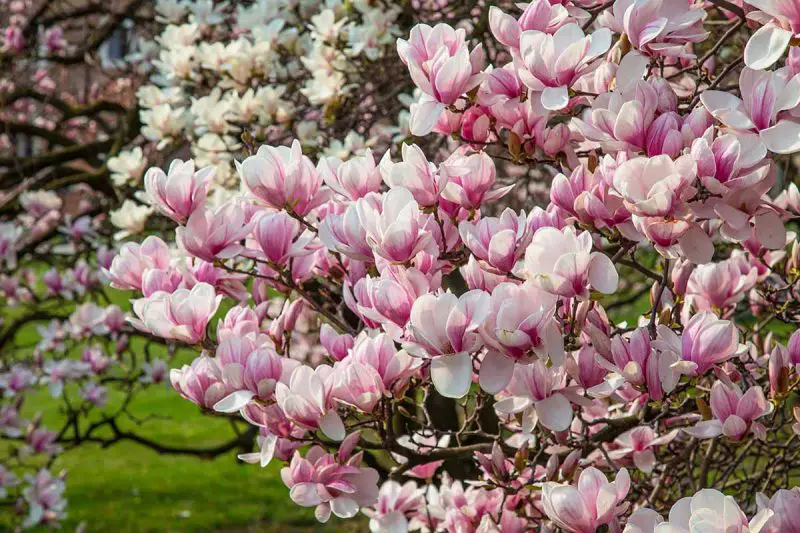Magnolia trees are beloved for their breathtaking blossoms and timeless elegance, but many gardeners wonder—how fast do magnolia trees grow and what can be done to help them thrive more quickly? Whether you’re starting from seed or planting a sapling, understanding their natural pace is key to nurturing a healthy, flourishing tree.
In this guide, you’ll discover the average growth rates of popular magnolia varieties, what factors affect their development, and practical, natural tips to boost their growth—all designed to help you enjoy beautiful magnolias sooner and more successfully in your garden.
Understanding Magnolia Growth Rates

Magnolia trees grow at different speeds depending on the species, age of the tree, and environmental conditions. While magnolias are not typically classified as fast-growing trees, many varieties show a steady, reliable pace that makes them ideal for long-term landscape planning.
Growth Categories: Slow, Moderate, and Fast
Magnolias are generally divided into three growth categories:
Slow-growing varieties, such as Magnolia virginiana (Sweetbay Magnolia), may only grow 6 to 12 inches per year in the early years. These trees are well-suited for compact gardens where controlled growth is preferred.
Moderate growers, like Magnolia grandiflora (Southern Magnolia), typically grow 12 to 24 inches per year once established. These trees may take 10 to 20 years to reach their full height of 60–80 feet but offer steady, manageable development.
Faster-growing deciduous types, such as Magnolia x soulangeana (Saucer Magnolia), can grow up to 24 inches annually under ideal conditions. These species often mature quicker and begin blooming within 3 to 5 years.
Growth Timeline by Tree Age
Magnolia growth can be broken into several phases. During the first two to three years, trees focus on root development. Above-ground growth may appear minimal, but strong root systems form during this time, laying the groundwork for healthier, faster growth later.
Between years 4 and 10, most magnolias enter their most active growth stage. The tree will grow taller and develop a fuller canopy, especially if well cared for. Some flowering will also begin during this period, depending on the species.
After year 10, growth begins to slow as the tree reaches maturity. While vertical growth decreases, the canopy continues to expand, and flowering becomes more consistent and abundant.
Factors That Influence Growth Rate
Several external factors influence how quickly magnolias grow. These include:
Soil quality and drainage
Sunlight exposure
Water availability
Regional climate and hardiness zone
Fertilization and general care
By choosing the right species for your region and providing proper care during each stage, you can maximize your magnolia’s growth potential and enjoy its beauty for decades.
Factors That Influence Magnolia Growth
Climate and Hardiness Zone
Magnolias thrive when grown within their recommended USDA hardiness zones, typically zones 5 to 9, but this varies by species. For example, Magnolia grandiflora prefers warmer southern climates and can grow vigorously in zones 7–9, while Magnolia stellata and Magnolia kobus tolerate colder climates and perform well in zones 4–6. Inappropriate zones—especially ones with harsh winters or extreme summer heat—can lead to slower development, delayed blooming, or winter dieback. Matching the magnolia species to your zone is the first step toward healthy growth.
Sunlight Exposure
Magnolias are sun-lovers at heart. Full sun exposure—at least six hours per day—promotes photosynthesis, which fuels faster growth, denser foliage, and more abundant flowering. Some species, like Magnolia virginiana, tolerate partial shade, but their growth rate and bloom quality may decrease. If planting in a hot, southern climate, consider providing some protection from harsh afternoon sun to prevent leaf scorch and help the tree conserve moisture.
Soil Type and Drainage
Magnolia roots are sensitive to compacted, poorly drained, or alkaline soils. They grow best in slightly acidic soils (pH 5.5–6.5) with excellent drainage and high organic content. Before planting, test your soil to ensure it drains well—dig a hole, fill it with water, and observe how quickly it drains. If water remains for more than a few hours, amend the soil with compost, leaf mold, or pine bark fines to improve drainage. Avoid planting magnolias in areas where water tends to pool after heavy rains.
Watering Consistency
During their first two to three years, magnolias need deep, consistent watering to establish an extensive root system. Young trees benefit from weekly watering during dry periods, especially in the summer. Once established, most magnolias are moderately drought-tolerant, though long dry spells may still reduce growth and flowering. The key is balance—keep the soil evenly moist without saturating it. Adding mulch around the base helps retain moisture and regulate soil temperature.
Fertilization and Nutrient Availability
While not heavy feeders, magnolias benefit from annual fertilization to support healthy growth. In early spring, apply a balanced fertilizer (such as 10-10-10) or one formulated for trees and shrubs. Avoid high-nitrogen fertilizers, which can cause lush foliage at the expense of flowers. Organic options like compost, worm castings, or seaweed extract are excellent for long-term soil health. Monitor leaf color—pale or yellow leaves may indicate a nutrient deficiency, particularly in iron or magnesium.
Root Space and Competition
Magnolia trees develop wide, shallow root systems that spread beyond the drip line. They need ample underground space to expand without competition from turf grass, large shrubs, or other trees. Planting too close to buildings, driveways, or crowded beds can hinder root growth and slow the tree’s development. For optimal growth, keep a wide mulch ring (2–3 feet or more) around the base of the tree, free of grass and weeds, to reduce competition and encourage better moisture retention.
Tree Age and Transplant Shock
Young magnolias, particularly those started from seed or recently transplanted, often grow slowly at first as they focus on root development. This “establishment phase” can last one to three years, depending on conditions. Transplant shock—caused by root disturbance, sudden changes in environment, or improper planting depth—can further delay growth. To reduce stress, plant in spring or early fall, water deeply, and avoid fertilizing for the first month after planting.
Pruning Practices
Unlike fast-growing shade trees, magnolias don’t respond well to aggressive pruning. Over-pruning, especially during the growing season, can shock the tree and slow growth. The best time to prune magnolias is late winter or very early spring, just before new growth starts. Remove dead, damaged, or crossing branches to improve structure and airflow. Avoid cutting into large limbs or the central leader unless necessary. Young trees may need only minimal shaping to encourage balanced form.
How to Naturally Boost Magnolia Tree Growth
Magnolia trees are known for their stunning beauty, but they can be relatively slow growers, especially in their early years. Fortunately, with the right care and environment, you can naturally accelerate their development without relying on synthetic growth stimulants. Below are essential strategies to enhance magnolia growth using organic, sustainable, and practical methods.
Improve Soil Health with Organic Matter
Healthy soil is the foundation for vigorous growth. Enhance your soil by regularly incorporating organic matter such as compost, well-rotted manure, leaf mold, or worm castings. These materials not only enrich the soil with slow-releasing nutrients but also improve its structure, aeration, and microbial life. For magnolias planted in poor or sandy soils, this step can dramatically boost root development and nutrient uptake.
Tip: Top-dress your magnolia tree annually with 1–2 inches of compost around the root zone in early spring.
Apply Organic Mulch for Moisture and Temperature Regulation
Organic mulch, such as shredded bark, pine straw, or wood chips, provides a natural layer of protection over the root zone. It helps retain soil moisture, reduce competition from weeds, and regulate soil temperature—all essential for steady, healthy growth. Mulch also gradually breaks down, adding nutrients back into the soil.
Application tip: Spread mulch in a wide ring around the base of the tree, keeping it 2–4 inches thick and at least 2 inches away from the trunk to prevent rot.
Use Companion Planting for Soil Enrichment and Pest Reduction
Certain companion plants can help magnolia trees by attracting beneficial insects, repelling pests, or improving soil conditions. For example, planting nitrogen-fixing legumes nearby, such as clover or lupine, can naturally enrich the soil. Aromatic herbs like lavender or basil may deter harmful insects, while groundcovers like creeping thyme can suppress weeds and reduce soil compaction.
Choose companions that won’t compete heavily for root space or light, especially in the first few years.
Harvest Rainwater for Deep Watering
Magnolias thrive with deep, consistent watering, especially in dry or windy climates. Instead of relying on tap water, use harvested rainwater stored in barrels. It’s free of salts and chemicals, naturally pH-balanced, and ideal for sensitive magnolia roots. Water deeply but infrequently, allowing the soil to dry slightly between waterings to encourage deeper root growth.
Guideline: Apply water slowly and directly at the base, allowing it to soak down at least 12 inches.
Encourage Mycorrhizal Fungi Development
Mycorrhizal fungi form beneficial relationships with plant roots, extending their ability to absorb water and nutrients. These fungi occur naturally in undisturbed soils but can also be added through inoculants or by incorporating forest leaf litter into your soil. Avoid synthetic fungicides or over-tilling, which disrupt these beneficial networks.
You can buy mycorrhizal inoculants designed for trees and shrubs and mix them into the soil when planting or watering.
Minimize Stress with Proper Site Placement
Magnolias that struggle with wind, extreme temperatures, or poor drainage are less likely to grow vigorously. To naturally boost growth, choose a location that is protected from harsh elements and allows for good air circulation. Morning sun with afternoon shade works well in hot climates, while full sun is ideal in cooler areas.
Ensure there is enough space for roots to expand freely without interference from concrete, large shrubs, or lawn competition.
Time Light Pruning to Stimulate Growth
While heavy pruning can stress magnolia trees, light, strategic pruning encourages bushier growth and improved structure. Remove crossing branches, suckers, and dead wood in late winter before the tree breaks dormancy. This reduces energy drain and directs nutrients toward productive growth areas.
Avoid pruning during active growth or in late summer, which can reduce flower bud formation for the next season.
Avoid Over-Fertilizing—Let Nature Lead
Synthetic fertilizers may produce a temporary burst of growth, but they can also weaken the tree in the long run by reducing root mass and encouraging soft, pest-prone tissues. Instead, use natural sources of nutrients, like compost tea, seaweed extract, or fish emulsion, to feed the tree slowly and steadily.
Focus on building long-term soil fertility instead of quick fixes. A healthy magnolia growing in living, balanced soil will naturally grow faster and stronger.
When to Expect Full Maturity
Magnolia trees are admired for their elegance and long lifespan, but they are not known for growing quickly. The time it takes for a magnolia to reach full maturity depends on several factors, including the variety, growing conditions, and how the tree was propagated.
Magnolias grown from seed usually take between 10 and 15 years to reach full biological maturity. This is the stage when the tree begins to bloom reliably and develops a well-formed, stable canopy. On the other hand, magnolias propagated through cuttings or grafting can bloom much sooner—typically within three to five years—because they inherit the maturity of the parent tree.
You can recognize a mature magnolia by its broad, symmetrical canopy that maintains a consistent shape over time. Mature trees also produce flowers annually in large numbers, and their growth rate tends to slow as they focus more on maintaining structure and expanding their root systems rather than growing taller.
Several key factors influence how long it takes for a magnolia to mature. Different species grow at different rates; for instance, Southern magnolia (Magnolia grandiflora) typically takes longer to mature compared to smaller varieties like Star magnolia (Magnolia stellata) or Saucer magnolia (Magnolia × soulangeana). Climate also plays a significant role—trees in regions with abundant sunlight, well-drained soil, and consistent moisture generally mature faster. Proper care, including adequate watering, balanced organic feeding, and minimal pruning, also helps accelerate the maturing process.
Realistically, most magnolias start blooming reliably between the seventh and tenth year when grown under ideal conditions. Seed-grown magnolias require patience, but the payoff is a beautiful, long-living tree that can thrive for fifty to over one hundred years. Once fully mature, a magnolia becomes a timeless centerpiece in the garden and a living legacy for future generations.
Frequently Asked Questions About Magnolia Tree Growth
How fast do magnolia trees grow each year?
On average, most magnolia trees grow between 1 to 2 feet per year, depending on the species and environmental conditions. Fast-growing varieties like Saucer magnolia (Magnolia × soulangeana) may grow slightly faster under ideal care, while slower types such as Southern magnolia (Magnolia grandiflora) grow more steadily and may focus on root development in the early years. Growth rates also depend heavily on sunlight exposure, soil fertility, and watering consistency.
Do magnolia trees grow faster in pots or in the ground?
Magnolia trees generally grow faster and stronger in the ground. When planted in open soil with room to spread their roots, they benefit from more consistent moisture and better nutrient access. Container-grown magnolias are suitable for compact spaces, but their growth is often slower due to root restriction and limited soil volume. If grown in pots, magnolias will need more attentive watering, feeding, and eventual repotting or transplanting to avoid stunted growth.
Can I speed up magnolia growth with fertilizer?
Yes, but it’s important to use the right type of fertilizer and apply it properly. A slow-release, balanced fertilizer with equal parts nitrogen, phosphorus, and potassium (such as 10-10-10) can support steady growth. However, over-fertilizing—especially with too much nitrogen—can result in excessive leafy growth at the expense of flowers and root development. For best results, feed once in early spring and again in midsummer, and always water well after application.
What’s the best magnolia variety for fast growth?
If you’re looking for a magnolia that grows quickly, consider the Saucer magnolia (Magnolia × soulangeana) or Star magnolia (Magnolia stellata). These types tend to establish faster, bloom earlier, and grow at a more vigorous pace than larger species like Southern magnolia or Sweetbay magnolia. Smaller varieties also tend to reach maturity sooner and are ideal for gardeners who want faster results in smaller landscapes.
Why isn’t my magnolia tree growing?
Several factors could be slowing your magnolia’s growth. Common issues include poor drainage, insufficient sunlight, overwatering, nutrient deficiencies, or root-bound conditions if the tree is potted. Soil pH that is too alkaline can also restrict nutrient uptake. To encourage growth, check the tree’s environment: ensure it’s getting at least 6 hours of sun per day, that the soil is slightly acidic (pH 5.5–6.5), and that water drains well. Pruning too early or too aggressively can also shock young magnolias and set back growth.
Conclusion
Magnolia trees may not be the fastest growers in the garden, but their steady pace reflects their strength and longevity. Understanding how fast magnolia trees grow helps set realistic expectations while guiding you in creating the right conditions for healthy development. With proper soil, sunlight, water, and care, you can naturally boost your magnolia’s growth and enjoy a graceful, blooming tree for generations to come.






